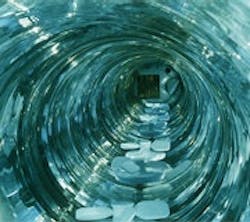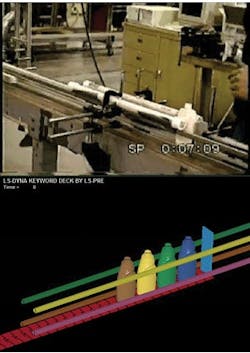Simulations Branch Out
By Jim Montague, Executive Editor
Virtual reality is getting more real every day. Historically, simulation was the realm of NASA, aerospace, large automotive production-line applications and other big-ticket applications. However, faster and cheaper data processing is bringing simulation to new users and types of equipment in a data-driven and seemingly inevitable progression from design and configuration to training for routine and exceptional events, and more recently to optimization, which even seems poised to knock on the door of real-time operations.
Seeking Realism
"Modeling and simulation are starting to transform our consumer packaged goods industry for the same reasons as other industries—it costs too much and it takes too long to build physical learning cycles, and so the products they produce aren't innovative," says Tom Lange, Procter & Gamble's (www.pg.com) modeling and simulation director.
"We look at things before they really exist because computers now are faster than the fastest computers in the world just 10 years ago. This power allows us to replace physical cycles with virtual ones and pursue realism," explains Lange. "So, instead of building a model, doing some calculations, getting close to the physical experiment and securing some guidance, realism means making a model that's indistinguishable from the physical experiment. This requires using our computing power for much bigger and more complex problems—doing parametric studies instead of point estimates."
[pullquote]For example, P&G experimented with a more user-friendly bottle shape for dish soap a few years ago, but found it didn't move along a race track/production line very well.
"The production guys talk about how a bottle design needs two points of contact and needs to address its center of gravity," explains Lange. "The product-identity guys say the new design is needed to reach consumers. However, a physical experiment still takes a long time. You have to make a mold and bottles and then get into a plant and run them. This can take three months and $100,000, even though it only takes about five minutes to find out if the new design worked. If designers can create a virtual bottle race track in 1-4 hours, we can check how a new bottle design will run on it in an hour, and everybody can see if it works. And, because it's a simulation, we can test bottle designs we'd never actually want to make." (Figure 1)
Similarly, programming robots and their complex motions never has been a picnic, but computer-aided design (CAD) tools and early simulations used to validate designs also evolved to make implementing robotics easier, according to Andy Jones, general manager for Applied Manufacturing Technologies' (AMT, www.appliedmfg.com) automotive business in Orion, Michigan. AMT is a complete manufacturing and engineering systems designer and builder, mostly for discrete machines and robotic applications.
"AMT's owner started 21 years ago when offline programs were just beginning to be added to robots," says Jones. "Since then, data handling has grown to process far more information, so CAD and other data translates more seamlessly. This means it's easier to program and validate robots off-line in a generic language and then pour that knowledge back into plant-floor robots in their native language. Likewise, simulation environments are getting more generic, and so simulation packages can program each robot controller closer to how the robots will run in the real world. Basically, the simulation environment talks to the emulator for each robot manufacturer.
This means the simulation runs just like a real robot. Ten to 15 years ago, there was about a 20% difference in cycle times between the simulation and real operations. Now it's a fraction of 1%."
Jones adds that AMT sees simulations now being used how they're supposed to be, namely for early process development and identification of what users want the robot to do and how the system should look, for mechanical design and CAD functions, and for communicating ideas to enterprise-level managers and customers. "Simulation can do virtual prototyping, but then it can also verify performance and throughput," adds Jones. "We can link a simulation model to actual PLCs, validate logic before building anything, and then make changes later when new capabilities need to be added. When you think simulation has reached its full capabilities, something new comes along."
Better Math = Closer Reality
At the root of all simulations, driving them and their software's increasingly sophisticated capabilities and new applications, is a pile of mathematics and faster calculations. What's sometimes lacking is user understanding.
"A good simulation can check that all your inputs and outputs act as they should, but people still think they have to do manual trial-and-error with devices such as VFDs," says Neil Koepke, marketing manager, Yaskawa America's Drives and Motion division (www.yaskawa.com). "They don't think you can simulate hardware. So, four years ago, we developed simulation software for our 1000 Series products. Now users wire drives to the software, connect power, run programs and punch keys as if they were using real equipment."
Virtual Snacks, Coming Attractions
Once simulation improves a user's machines, production lines and packaging, they might look for other items to simulate—even potato chips. Lange says P&G now makes its Pringles potato chips so fast—about a billion every few hours—that it recently simulated the aerodynamic forces acting on the chips to keep them from flying off its production machines and to better coat them with seasonings.
"We found that air pressure was building up on the front and back edges of the chips, and we had to find a way to keep them on the line, so they wouldn't end up as pig food," says Lange. "Distributing seasonings evenly was an even more serious problem. The simulation showed that we couldn't just blow the seasonings into this airflow, and so we learned that we had to spray them on instead."


